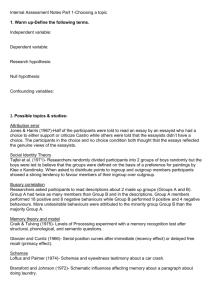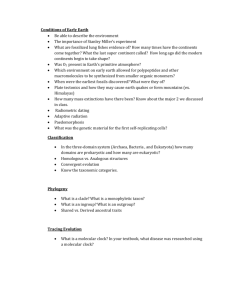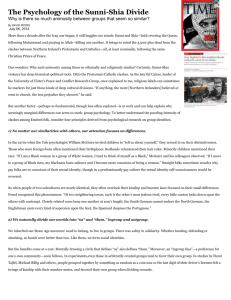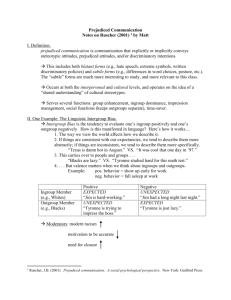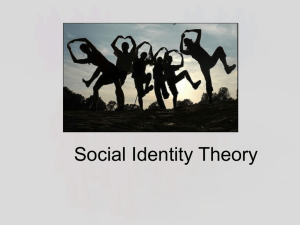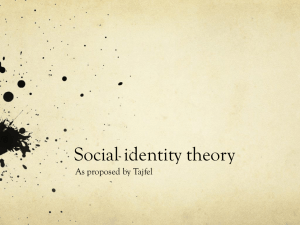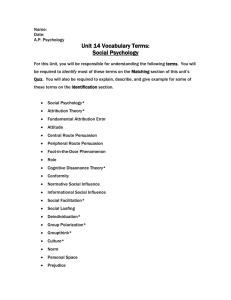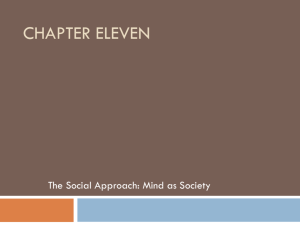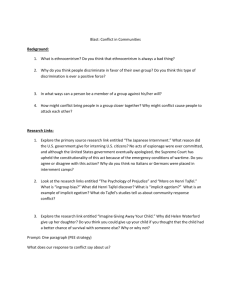Lecture12
advertisement
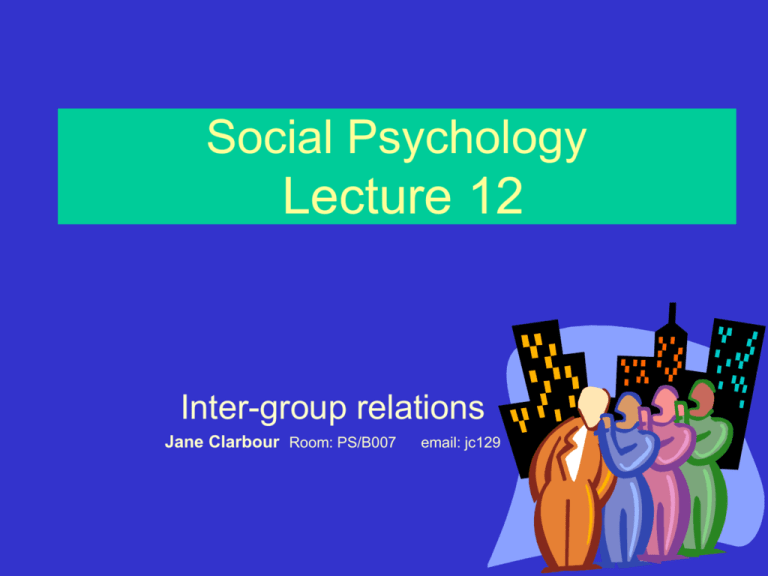
Social Psychology Lecture 12 Inter-group relations Jane Clarbour Room: PS/B007 email: jc129 Objectives • Give an account of the role of social categorization in group behaviour • State significance of what is termed the ‘maximum difference’ in favour of the ingroup • Demonstrate an understanding of the basic principles of Self-Categorization Theory • Consider the implications of Social Identity Theory for wage bargaining • Discuss the role of social categorization in defining what is meant by a social group. THE SHERIF EXPERIMENTS • Competition as a ‘key’ element in group differentiation – Observations were divided into different stages: • • • • Stage 1: acquaintanceship Stage 2: group differentiation Stage 3: competition Stage 4: cooperation (for later study) Sherif’s findings • Results – Cooperation friendships increases • not occurred since acquaintanceship) cross-group Stage 1 (Group Conclusions – Competitive goals cause inter-group conflict – Superordinate goals cause inter-group co-operation. Social categorisation • Social categorisation can lead to intergroup discrimination – Them vs. us • Discrimination against outgroup – Favour the ingroup Bristol inter-group relations project Tajfel et al (1971) Experiment 1: Dots ‘Minimum group’ effects of categorisation on inter-group behaviour – (i) Neutral condition – (ii) Evaluative condition • Nature of choices (reward/penalty): – Ingroup: 2 members (own group) – Outgoup: 2 members (other group) – Intergroup: 1 member (own) / 1 member (other group) Group classification Ss then told they will: – allocate rewards (real money) to other Ss. – and other Ss will allocate rewards to them • They were not told the names of the Ss but they were told the groups • At no time would they allocate money to themselves Findings No difference between the value and neutral conditions. – But striking differences over 3 choices: • For ingroup and outgroup choices – principle of maximum fairness was observed. • For differential choices – strong ingroup preference. This is a striking result in that we might have expected Ss simply to have tried to make as much money out of the experiments as possible. Maximum difference Tajfel et al (1971) Experiment 2: Klee & Klandinsky • Maximum joint payoff – Maximum common benefit (10p/10p cf. 8p/5p). • Maximum ingroup payoff – highest points to the ingroup member (10p/5p cf. 7p/7p). • Maximum ingroup difference – greatest difference in favour of ingroup. (10p/5p cf.12p/10p). Conclusions • Minimal ingroup-outgroup social situation created without even group interaction • And, when categorised on trivial defining attribute • Ss still preferred to assist their own group rather than gain maximum profit for all. – So, intergroup bias can be explained in terms of group similarity effects More minimal group experiments… BILLIG & TAJFEL (‘73) • Was cause similarity? – Varied group similarity with categorisation • (4 groups) – Subjects were told of random placement into group – Ingroup bias regarding distribution of reward still evident towards ingroup even when Ss were dissimilar Experimental bias? BILLIG (1976) Increases in ingroup favouritism found with expectation of both: competitive interaction Cooperative interaction Increased most with existing and meaningful categories Social Identity Theory (SIT) • Based on Festinger’s theory of social comparison processes: – Individuals have a drive to compare themselves with others – This generates information for selfevaluation Positive social identity • Social groups strive to develop positive social identity – Positive social group identity is achieved at expense of outgroup Re: the Bristol matrix studies• Ingroup bias is a means for Ss to achieve positively valued group distinctiveness – Not a product of group distinctiveness. – Positive ingroup identity only achieve by awarding more money to the ingroup than to the outgoup Real life parallels – Generality of Tajfel’s findings • Domingo £1 paid more than Pavorotti at Wembley • Brown’s (1978) Factory worker study – Study of industrial relations in engineering factory (aircraft engines). – Studied 3 groups of workers • Toolroom • Development • Production (By order of status) Pay-roll negotiations • Shop stewards selected randomly from all parts of factory to negotiate wage increases – Presented matrices like Tajfel’s experiment • Toolroom – vs- Production & Development • Development – vs- Toolroom & Production • Production – vs - Development & Toolroom Results of pay-roll negotiations • Production stewards (lowest status) – aimed for parity with development (next one up) • Development stewards – aimed for maximum difference from production workers (one below) • Toolmen (highest status) – also aimed for maximum difference even to extent of taking £2 per week cut in salary! Conclusions from pay-roll negotiations • Rewards are used to establish positive ingroup identity • Preferred strategy is the differential • Supports Tajfel’s findings on ingroup bias Social implications • Categorisation defines people as a group • Categorisation is necessary condition to produce discriminatory behaviour between groups Emerson (1960) quote: “A nation is a body of people who feel that they are a nation”. If people think of themselves as a group, then they are a group… So, at the next group meeting we’ll discuss this further…. Self-Categorization Theory TURNER et al. (1987) • Shared social categorization of themselves in contrast to others – Forms basis of attitude & behaviour • Cognitive process • Depends upon social situation When categorise self as: individual personal goal group group goal People standing at bus stop not a psychological group – unless think so! Criticism of Social Identity Theory MUMMENDEY (1995) – Inter-group research principally focused on distribution of positive resources • (i.e. points or money) Social treatment of groups • Stereotype – a perception that most members of a category share some attribute due to: • ‘Outgroup homogeneity’ – the tendency to see outgroup members as all alike • Prejudice – negative attitude, emotion or behaviour towards members of a group on account of their membership of that group • • • • Religion Gender Football supporters Disabled Black sheep effect – ingroup members judged more harshly than outgroup in order to maintain positive social identity • When the ‘black sheep’ strays too far from group norms - becomes excluded (Marques & Paez, 1994) Social cohesion • The extent that group members view one another as matching group prototype (Hogg, 1987). SUMMARY • Social Identity Theory – Groups seek to achieve a positive social identity typically at the expense of other groups. • Maximum difference in favour of the ingroup/differentials – A way of establishing a positive identity • Self-Categorisation Theory – Individuals who share a common categorisation of themselves in contrast to others may be regarded as a group. Key reading • Baron et al (1992) – Group process, group decision, group action – Chapter 8: Group aggression and intergroup conflict • Brown (1978) – Divided we fall: An analysis of relations between sections of a factory workforce • Mummendey (1995) Tutorial 4 – Positive distinctiveness and social discrimination • Tajfel (1971) Tutorial 4 – Social categorisation and intergroup behaviour.
